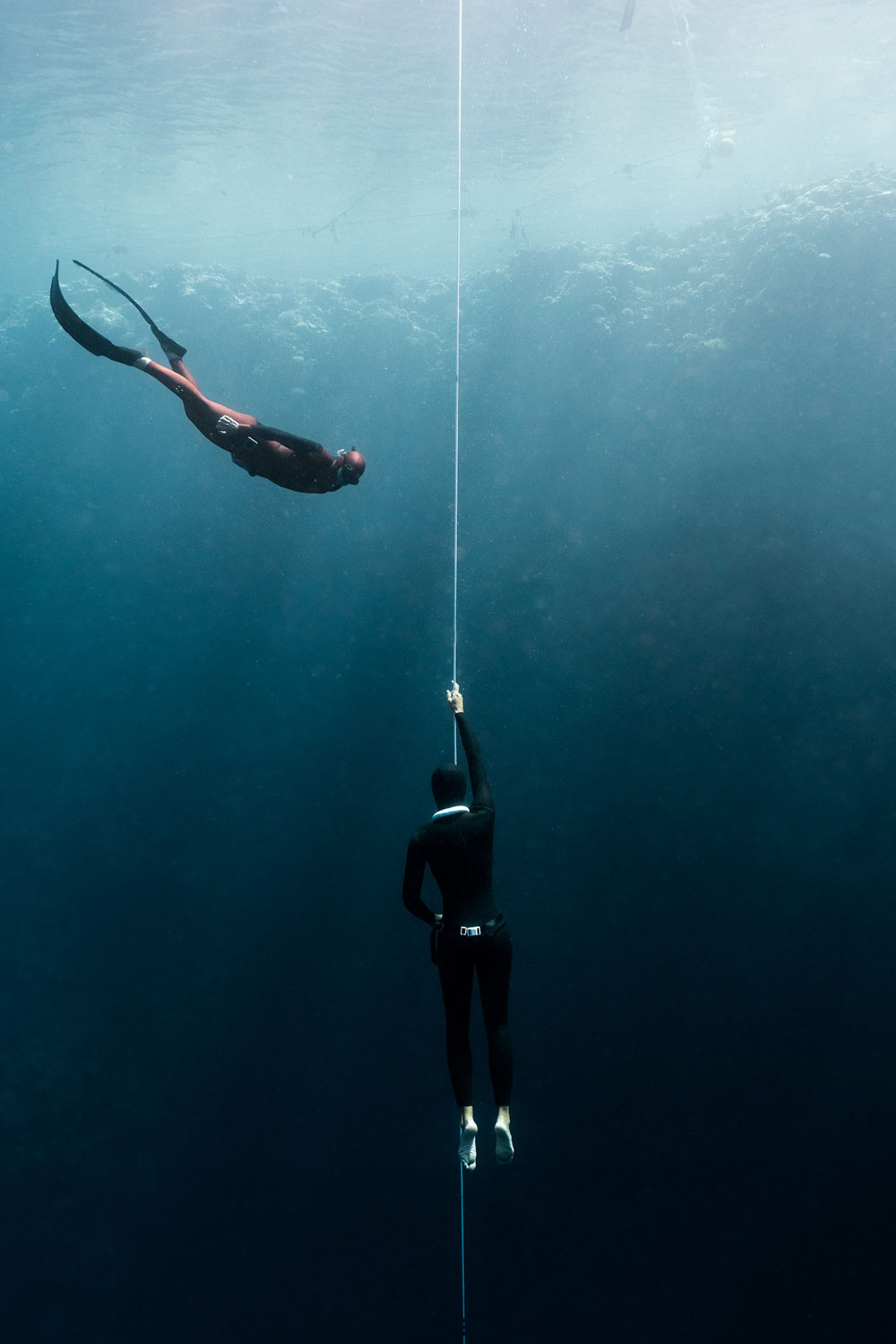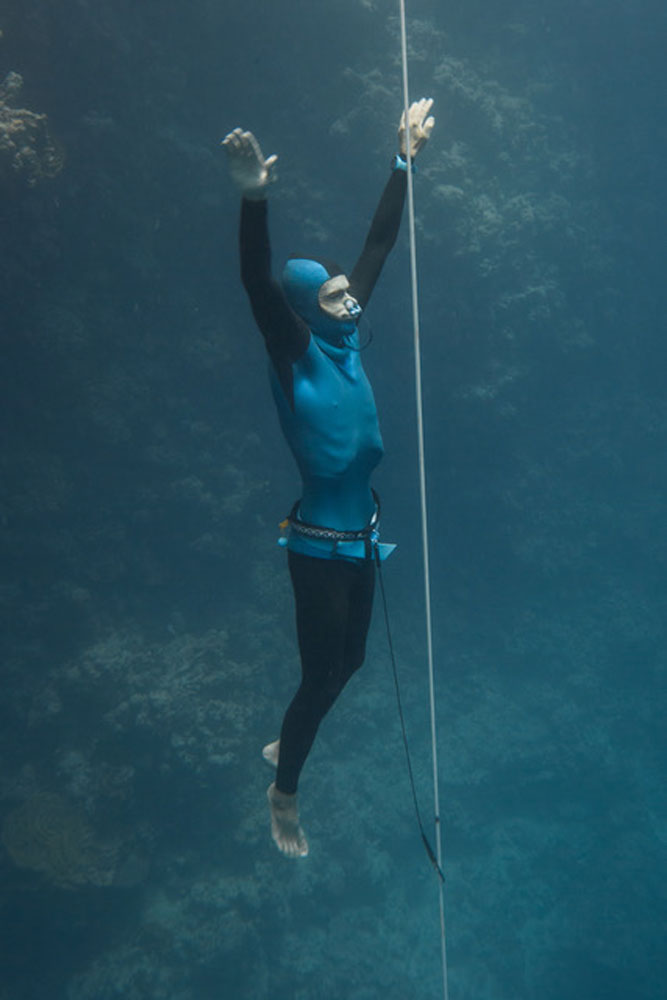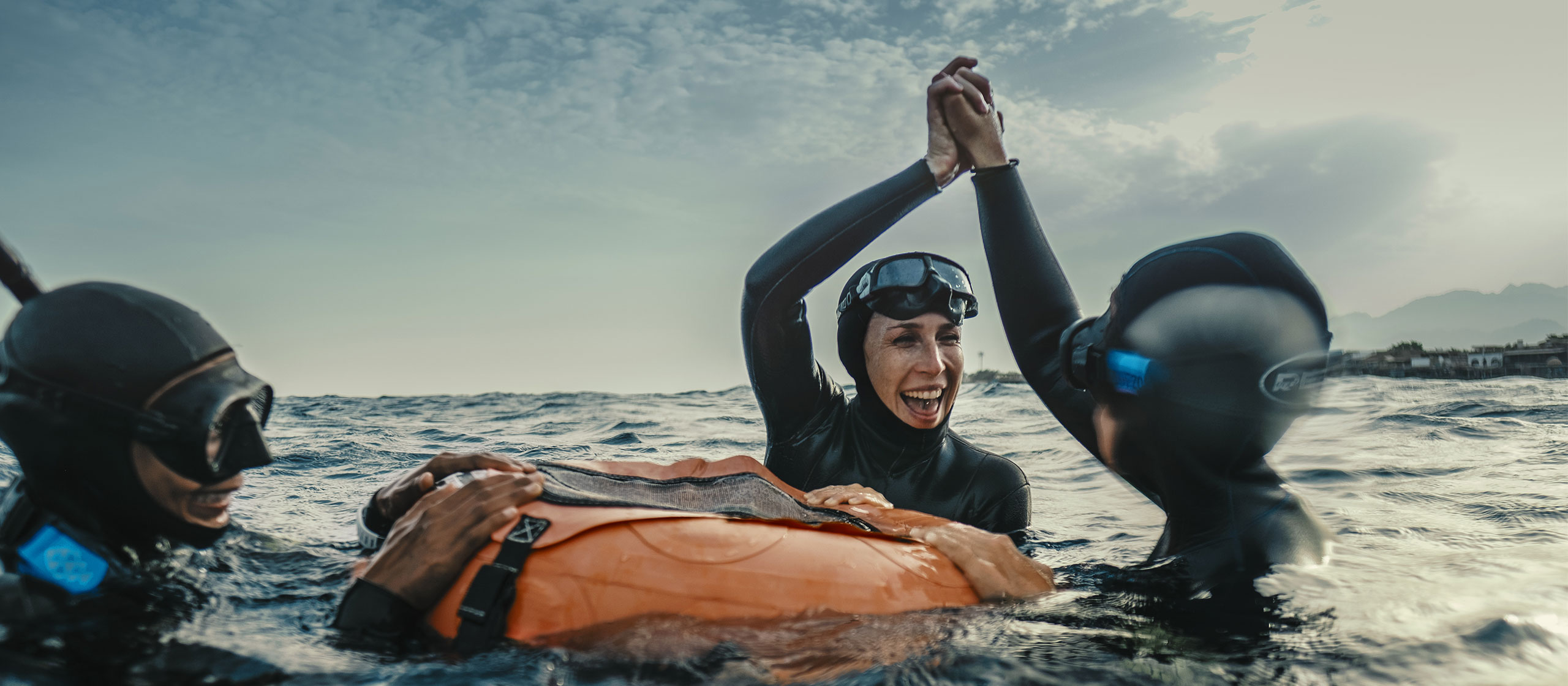Dive stories
Adaptations we experience in freediving – Part II
Previously we started looking at the adaptations that we experience when we freedive. I asked experts in freediving Nathan Vinski, Carlos Diezel, and Lily Crespy what they thought about how our bodies adapt, and began to explore the ways.
Let’s continue looking at more adaptations and what our experts suggest when it comes to training for these adaptations.
Adapting equalisation techniques
Lily pointed out that adapting to pressure changes as we dive deeper, usually means having to adapt our equalisation techniques, too: “In deep freediving you need to adapt firstly to pressure. That means being flexible enough to dive to certain depths without injuring your lungs or trachea. And it also means adapting your equalization style to the depths you are diving. For example a beginner might be able to equalize using the Valsalva technique (pushing with the abdominals to equalise the ears) to about 10m, but then he/she will need to learn Frenzel equalization (contracting the throat to equalise the ears). Frenzel equalization can work even for very deep dives, but many people choose to switch to mouthfill equalization (storing air in the cheeks to equalise the ears) to dive past 40m-50m, just to be less at risk of lung injuries.”
Mental adaptation to depth
Freediving is undoubtedly a mental sport. It mostly boils down to relaxation and control of the mind. Of course physical aspects play a part but training the mind to adapt to depth is just as (if not more) important as training the body.
Lily makes a good point about resisting our natural instincts that tell us to head back to the surface: “The deeper we go, the further away we are from the surface, from that oxygen that keeps us alive. This for sure triggers deep ancestral fears in our brains, and we need to let our minds adjust to deeper and deeper depths, to be able to dive there while staying relaxed, calm and confident.”
Nathan says: “Some freedivers argue that ‘depth adaptation’ is mostly or even purely mental. I personally disagree with this, but of course getting used to the feeling of compression is extremely important. If you're not comfortable with this, it's easy to tense up your breathing muscles, fighting against the compression, and increasing the risks of pressure related injuries or problems.”
Even if a freediver is in the best physical shape possible, if their mind is distracted, if they’re not comfortable with the increased level of pressure or darkness at depth, or they are not confident with the depth they are diving to, they could turn early and not make their target depth, or worse, experience a deep water blackout.
Carlos says: “For divers between around 25m-30m the adaptation is mostly mental; having a level of relaxation and peace of mind is enough to prepare them for this depth. Beyond 30m-40m there are more physical components which become relevant.”
With a good training plan that builds depth gradually, your mind can adapt and become comfortable with deeper freediving. This is true regardless of the depth you are diving to. When you first start freediving, 10m can often feel daunting and scary, but with a gradual increase, and repetitive dives, it soon feels completely comfortable. Your mind adapts and your perception of what a “deep dive” is changes.

Nathan by Elin Larsgren
Hypoxia and CO2 adaptations
When we freedive, it is normal to experience CO2 build up. This is what can trigger the urge to breathe and create an uncomfortable feeling for those who aren’t used to it. Hypoxia also occurs as our oxygen supply starts to deplete, this also feels uncomfortable and can lead to black outs if we are not careful.
When freedivers train frequently, their tolerance for CO2 becomes higher and the urge to breathe can be delayed. They become more adapted to that uncomfortable feeling, too. CO2 tables are a training method that many freedivers follow to increase their CO2 tolerance and adapt to the feelings it brings.
Hypoxic training can be done, too. Freedivers that train regularly can delay the uncomfortable feelings of hypoxia and become more adapted. A good way to train hypoxia is with dry physical exercises on breath-hold.
Adapting to narcosis
Yes, freedivers csan experience narcosis, too. Very little is known about narcosis, and it can be experienced in many different ways, some hear sounds, others feel euphoric, and some might experience strange visual distortions.
Lily says: “Freedivers may need to adapt to narcosis, which can be very variable from diver to diver, some freedivers already experience it at 50m, while others feel nothing even on 70m dives. For a given freediver, it will also vary from day to day depending on conditions (especially darkness for example), and their mental and physical state.”
It’s hard to say whether narcosis can be delayed or controlled with repetitive dives, but surely getting used to these feelings by diving often will prepare you to stay calm if they occur.
When do these adaptations become relevant?
So do divers of all levels need to think about these adaptations or only those who dive to extreme depths?
Carlos suggests that most adaptations become more relevant the deeper you dive: “I think between 30-40m is when it becomes relevant, but I think it’s more noticeable when you are diving beyond 50m, this is when a diver normally notices if it is happening in a smooth way, or if more training for adaptation is required before going deeper.”
Nathan thinks that these adaptations start to become relevant from as shallow as 10m-15m: “This depth is technically going to place a diver below their natural FRC (functional residual capacity) which is the smallest lung volume that we normally experience in day-to-day life. We need to be comfortable with lungs that are smaller than this if we are going to be comfortable at depth.”
However, he says that adaptations become increasingly more important to consider as we dive deeper: “Below our natural RV (residual volume) -which will occur around 30-40m for most people- diving deeper and deeper depends almost fully on an increased comfort and adaptation to compression.” / “ It's unique to freediving, meaning that for some people even at 25m, or even 15m, these new sensations could cause problems with equalization and just general discomfort. That being said, the real danger starts to really happen deeper than 30-40m when the lungs reach RV, and for safety reasons "depth adaptation" becomes more important and delicate.”

Lily by Elin Larsgren
Lily says that adaptations are relevant in different ways at all depths and experience levels: “I have seen beginners stop at 5m and come back to the surface saying it's because ‘they felt they were running out of breath’: at this stage, their mind needs to adapt to allow them to go from 5m to 10m. Divers getting stuck at 12m because their Valsalva equalization can't take them deeper will need to adapt their equalization technique to go to 20m. Some might need to adapt their lungs' flexibility or equalization to dive past 30m-40m when getting close to their residual volume. Divers going deeper than 70m might start to feel the effects of narcosis and take time adapting to these. And people freediving to 90+ might start feeling the need to adapt to hypoxia or to adapt their muscle strength to make the way back. In my opinion, adaptation to depth is happening at any level, is composed of many elements and is different for all freedivers, and any given freediver will go through many of these adaptations during his/her freediving progression.”
How to train to prepare for adaptations in freediving
The mammalian dive reflex happens on its own, but flexibility and mental preparation needs to be considered when developing a training plan to get us to our desired depth in freediving.
But how much time do we need to set aside in training for these adaptations?
Nathan says that everyone is different but there are general rules of thumb to go by: “There are many factors that include genetics, training frequency, training quality, and the actual depth that a diver is currently at. In my experience, depending on the person, you can expect to reach around 40m safely and comfortably within around 6-18 months of training, and then beyond that "natural RV" point, a safe amount to add is going to be around 5-10m per year.”
Carlos believes it takes years of training to truly prepare for adaptations in freediving: “It’s a long process for those going to greater depths. It can take years. However when a diver is starting out, inexperienced freedivers will start to adapt after a few weeks. The body and mind start getting used to depth and allowing the body to do its job. For experienced freedivers who come back to freediving after a break, a few sessions are necessary, maybe a week or two to re-adapt.”
Lily believes it really depends on the type of adaptation you might be struggling with: “The amount of time depends on which types of adaptations we are talking about. For example, switching from Valsalva to Frenzel can be done in a matter of days. Whereas adapting to hypoxia or narcosis is usually a longer, slower process.”
Of course training depends massively on the mental strength of a person and their ability to relax, as well as the physical side. Unfortunately, there’s no rule of thumb for this, some people are mentally prepared for freediving from day one. For others it can take months or even years to adapt their mind and let go of their nerves or their uncomfortability with the feeling of increased pressure. Meditation and visualisation can be very beneficial for those looking to quiet their mind and prepare for mental adaptations in freediving.
Using his suggested exhale diving training that I mentioned above, Nathan says that preparing for the physical adaptations in freediving makes up for around one third of the total training programme he puts together for deep freedivers: “If you want to dive to let's say 60m (seven bar of pressure), you will reach a compressed lung volume of 1/7th your TLC (total lung capacity). This isn't within the "normal" function of the lungs, and this needs to be something that you develop 100% physical and mental comfort with. Achieving this means, approaching and experiencing this 1/7th TLC repetitively and at shallow depths using exhale training exercises.”
Carlos also suggested using FRC dives in training, but also thinks repetitions of PBs (personal bests) are essential to prepare for adaptations: “We have to repeat depths close to our max, I think this is what brings the actual adaptations. When you are retraining your body and preparing it to go a little deeper, repetitions of depth, FRC dives, and a lot of dry work (lung stretches) is the required combination.”
 Carlos by Livio Fakeye
Carlos by Livio Fakeye
Lily agrees with Carlos, and says that freediving frequently is the only real way to adapt: “The best way to train for depth adaptation is to repeat your dives. You can of course, do many things dry and in the pool or in shallow water as well to keep in shape even in the off-season. But basically there's no real way around it: to adapt to freediving, you need to freedive. The more exposure you'll give to your body and mind, the more they will get used to the depths you're bringing them to.”
The human body is amazing in its ability to handle and adapt to extreme situations such as freediving. We are still learning so much about the physiological and psychological aspects of freediving, and I can’t wait to see what else we learn as incredible athletes continue to dive deeper and for longer.
Sources:


